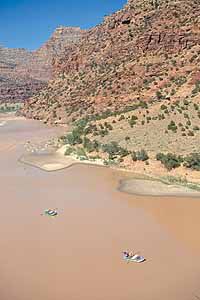| Desolation Canyon as it winds its way through the Green River basin. The Canyon has been used as a classroom for Prescott College for 30 years. It will now be the theme of a presentation scheduled for Dec. 7 in Price. |
This story began 30 years ago as part of a wilderness studies program at Desolation Canyon in Eastern Carbon County. For the past three decades students attending Prescott College in Northern Arizona have been traveling to Eastern Utah to study the river, the canyons and the desert.
The 84-mile section of Green River as it runs through Desolation Canyon, following the route of earlier explorer John Wesley Powell, is the deepest canyon in Utah. At its deepest point, Bright Angel Trail, it is over a mile deep. It has the largest wilderness study area in the 48 lower states and it is ideal for exploring, hiking and studying archeological sites and early settlement ranches, according to Dennis Willis, Outdoor Recreation Planner for the Bureau of Land Management in Price. Desolation Canyon is made up of more than 60 canyons all flowing into the Green River, which sits on the eastern edge of the Colorado Plateau. The Plateau runs from Vernal, Utah, south to Flagstaff, Ariz., east to Grand Junction, Colo., which includes the entire Price River drainage basin.
So for 30 years class after class of Prescott college students learned from the unique training grounds in Desolation Canyon, but as the area became more popular the BLM found it necessary to make this area of the Desolation Canyon a limited access area. But that means that the college needed to be lucky enough to be selected. A lottery is held each February and from the more than 4000 applications only 400 are selected to make the trip. This past year Rachel Peters, permit coordinator for the college and Willis were serving on a panel of river managers discussing the importance of having recourses like Desolation Canyon available to groups for learning. The question was, why weren’t they making special accommodations for these types of groups?
Following the formal discussion, the meeting continued between Willis and Peters and she wondered if the college could sponsor a service project but the thought of something like a cleanup project or serving the trails seemed like such a waste for a strong liberal arts college like Prescott College.
Willis found himself asking Peters, “What can your students do that we can’t?” They thought about this area as a limited access area, not well known, with few people ever hearing about its uniqueness and really appreciating it so it can be protected.
Peters threw out the idea of using arts, literature, dance and visual arts to communicate how special Desolation Canyon is. At this discussion, the thought was born that Prescott College would create a presentation and perform it to the Carbon County community as a way of saying thank you.
| Neil Breinholt, owner of Breinholt Music is pictured discussing the technical issues for an upcoming presentation by Prescott College. Pictured from Prescott with Breinholt is Liz Faller, instructor and artistic director and Bryndl Mar and Greg Burhop, co-student production coordinators. |
From this point the project was in motion and under an administrative permit 12 students and three instructors spent nine days on the river earlier this month. They launched near Myton, in the Uinta Basin and traveled the 84 miles down river, getting out about 12 miles north of Green River. As it has for the past 30 years the canyon served as the classroom for the nine days and 12 students. But this time they had another goal in mind; they were gathering material for a presentation. They were introduced to the spectacular fall scenery of the canyons, the numerous and unique archeological sites, the settlements, the wildlife, geological features and unique plant life. From Desolation Canyon they traveled to Price and spent four more days researching the community. It was a whirlwind trip as they interviewed people like Don Wilcox, rancher on the original settlement, and Don Burge, CEU Prehistoric Museum manager. They met community leaders, college officials, and technical supporters.
Liz Faller, instructor at Prescott College, summarized their efforts by saying, “it’s being done to thank your community.” She and the student co-producers Mar and Burhop were overwhelmed with the hospitality of the community. “We kept hearing the same message, whatever you need? However we can help? It’s been like this since the day we arrived in Price.”
Their trip up the Nine Mile Canyon to an ancient Freemont Indian Village showed the group how a community lives through their rock art. It gave the students a more realistic idea of how the Freemont peoples may have lived. It gave them ideas on set design and how they could tie in the ancient cultures to the western movement and development of this desert corner of eastern Utah.
According to Willis, “this will be purely a presentation of appreciation.”
The Prescott students are now back in Arizona creating their show, putting together the materials, developing dances, sets, and themes.
The show is coming to Price December 7.

